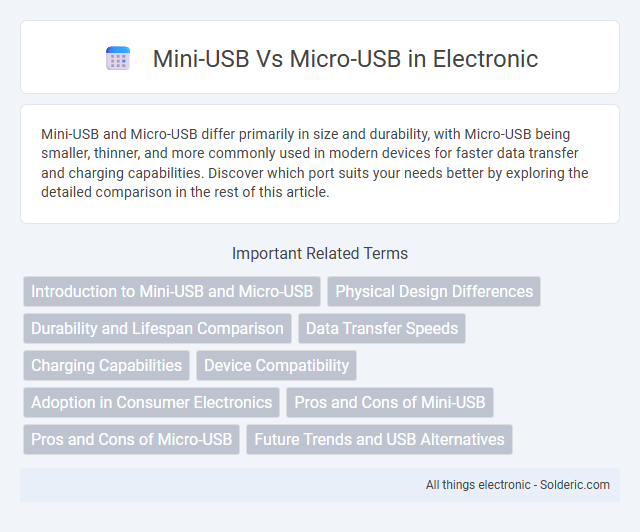Mini-USB and Micro-USB differ primarily in size and durability, with Micro-USB being smaller, thinner, and more commonly used in modern devices for faster data transfer and charging capabilities. Discover which port suits your needs better by exploring the detailed comparison in the rest of this article.
Comparison Table
| Feature | Mini-USB | Micro-USB |
|---|---|---|
| Release Year | 2000 | 2007 |
| Size | 3 x 7 mm | 6.85 x 1.8 mm |
| Durability (Insertion Cycles) | ~5,000 | ~10,000 |
| Connector Shape | Rectangular with beveled edges | Smaller, flatter, trapezoidal |
| Common Usage | Older digital cameras, MP3 players, some PDAs | Smartphones, tablets, external devices |
| Data Transfer Speed | USB 2.0 (up to 480 Mbps) | USB 2.0 and USB 3.0 variants (up to 5 Gbps) |
| Power Delivery | Up to 2.5W (5V, 500mA) | Up to 4.5W (5V, 900mA) |
| Compatibility | Less common in modern devices | Widely adopted standard before USB-C |
Introduction to Mini-USB and Micro-USB
Mini-USB and Micro-USB are two common USB connector types used for data transfer and charging electronic devices. Mini-USB, larger and typically found on older devices such as early digital cameras, offers durability but has largely been replaced by the smaller, more compact Micro-USB. Micro-USB connectors are widely used in smartphones, tablets, and other portable electronics due to their slim design and improved pin configuration, providing faster charging and data transfer speeds for your devices.
Physical Design Differences
Mini-USB connectors are larger, measuring approximately 3 x 7 mm, with a more rectangular shape and typically a thicker housing, designed for durability in early portable devices. Micro-USB connectors are smaller, about 6.85 x 1.8 mm, featuring a flatter and more compact design that allows for slimmer devices and improved insertion durability with up to 10,000 connect-disconnect cycles. The physical design of Micro-USB enables better space efficiency and enhanced electrical contacts compared to the bulkier Mini-USB standard.
Durability and Lifespan Comparison
Micro-USB connectors generally offer better durability and a longer lifespan than Mini-USB due to their more compact design and reinforced internal pins, supporting around 10,000 connection cycles compared to Mini-USB's 5,000 to 10,000. The slimmer build of Micro-USB reduces strain during frequent plugging and unplugging, making it more suitable for daily use. If your device requires reliable long-term connectivity, choosing Micro-USB can enhance performance and reduce wear over time.
Data Transfer Speeds
Micro-USB typically supports USB 2.0 standards with data transfer speeds up to 480 Mbps, while Mini-USB also adheres to USB 2.0, offering similar maximum speeds. Neither Mini-USB nor Micro-USB supports the faster speeds of USB 3.0 or above, which can reach several Gbps. For applications requiring higher data transfer rates, USB-C or USB 3.0 variants are more suitable than Mini-USB or Micro-USB connectors.
Charging Capabilities
Mini-USB and Micro-USB differ significantly in charging capabilities, with Micro-USB supporting higher current levels for faster charging compared to the older Mini-USB standard. Micro-USB ports commonly deliver up to 2.4 amps, enhancing device recharge speed and efficiency, while Mini-USB typically maxes out around 1 amp. Choose Micro-USB if you require quicker charging and improved compatibility with modern devices supporting faster power transfer.
Device Compatibility
Mini-USB connectors are primarily found on older devices such as early digital cameras, MP3 players, and some external hard drives, making them less common in modern electronics. Micro-USB has become the standard for many smartphones, tablets, and portable chargers, offering improved durability and a smaller form factor ideal for compact devices. While both connectors support USB 2.0 data transfer rates, Micro-USB's widespread adoption ensures broader compatibility with current devices and accessories.
Adoption in Consumer Electronics
Micro-USB has largely replaced Mini-USB in consumer electronics due to its smaller size and improved durability, becoming the standard charging and data transfer port for smartphones, tablets, and other portable devices. Mini-USB was common in older devices like digital cameras and early smartphones but is now mostly obsolete. Your devices will more likely feature Micro-USB ports for compatibility with a wide range of accessories and chargers.
Pros and Cons of Mini-USB
Mini-USB offers a sturdy and reliable connection with a compact design that fits well on older devices, making it ideal for durable use and moderate data transfer speeds. However, its larger size compared to Micro-USB limits space-saving on modern smartphones, and the connector is less common today, resulting in fewer compatible accessories. Your choice between Mini-USB and Micro-USB depends on device compatibility and the need for a more widespread, slimmer, and faster data transfer standard.
Pros and Cons of Micro-USB
Micro-USB offers widespread compatibility with many smartphones, tablets, and accessories, making it a versatile charging and data transfer option. Its slim design supports fast charging and data transfer speeds but lacks the reversible connector convenience found in USB-C, causing occasional user frustration. Durability issues arise from the fragile pins and connector shape, leading to wear and loose connections over time compared to more robust alternatives like USB-C.
Future Trends and USB Alternatives
Mini-USB, once common in older devices, is rapidly being phased out in favor of Micro-USB, which offers a smaller, more durable connector widely used in smartphones and portable electronics. Emerging future trends highlight USB Type-C as the preferred alternative due to its reversible design, faster data transfer speeds, and enhanced power delivery capabilities, leading manufacturers to adopt it for newer devices. Wireless charging technologies and proprietary connectors also present viable USB alternatives, emphasizing convenience and innovation in device connectivity.
Mini-USB vs Micro-USB Infographic

 solderic.com
solderic.com